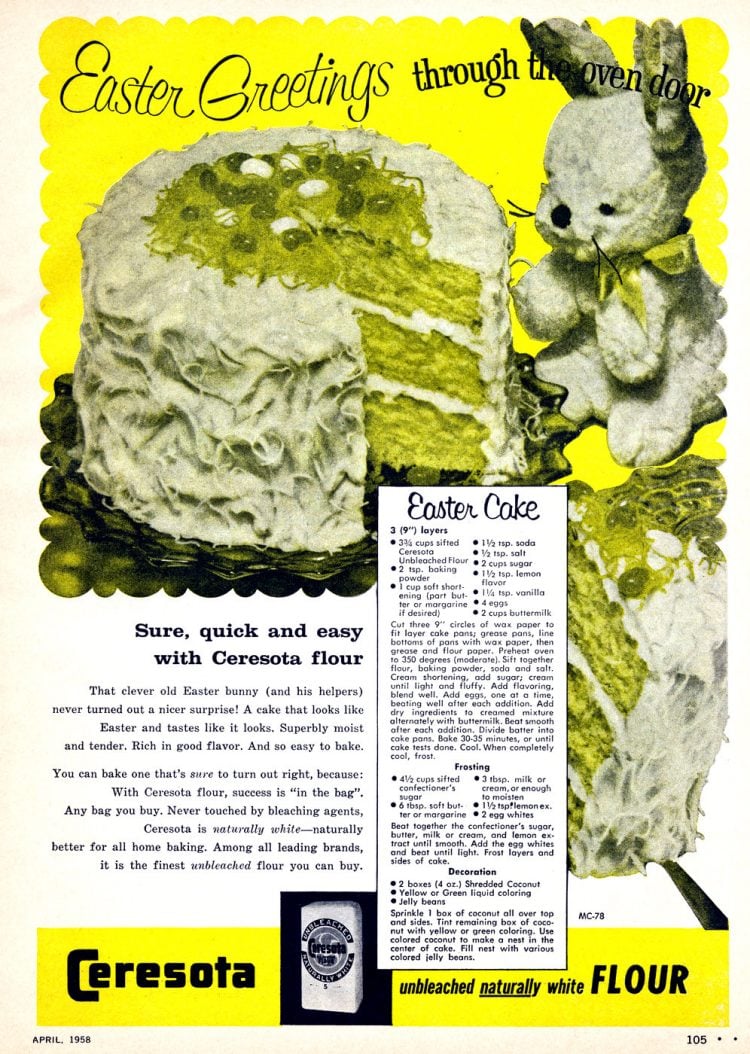Easter Greetings through and the oven door.
Sure, quick and easy with Ceresota flour.
That clever old Easter bunny (and his helpers) never turned out a nicer surprise! A cake that looks like
Easter and tastes like it looks. Superbly moist and tender. Rich in good flavor. And so easy to bake.
You can bake one that’s sure to turn out right, because: With Ceresota flour, success is “in the bag”. Any bag you buy. Never touched by bleaching agents, Ceresota is naturally white-naturally better for all home baking. Among all leading brands, it is the finest unbleached flour you can buy.
The Boy with the Sword: A Slice of Ceresota Flour History
If you’ve ever browsed through a vintage kitchen, flipped through an old cookbook, or baked a loaf of bread in the Midwest, you might have come across a bag of Ceresota Flour—instantly recognizable by its iconic image of a wholesome young boy holding a giant loaf of bread and a sword turned into a bread knife. But behind the charming artwork lies a fascinating story that goes back well over a century.
The Birth of a Brand
Ceresota Flour was born in the late 1800s, during a time when milling flour was a booming industry in the American Midwest. The name “Ceresota” is a creative blend inspired by Ceres, the Roman goddess of agriculture and grain, and the word “Minnesota,” where the flour was originally produced.
This high-quality, unbleached all-purpose flour quickly earned a reputation for consistency and excellence. It was especially popular for making hearty Midwestern staples like bread, biscuits, dumplings, and pie crusts.
The Iconic Little Bread Boy
Ceresota’s instantly recognizable logo—a young boy holding a giant loaf of bread and slicing it with a sword—is one of the most enduring and charming pieces of American food branding. Introduced in the early 1900s, the character became known as the Ceresota Boy, and he came to symbolize not just the flour itself, but wholesome, home-baked goodness.
According to some accounts, the idea was to turn the image of a tool of war (the sword) into something peaceful and nourishing (a bread knife). The message was clear: bread is life, and Ceresota was here to help you make it better.
Auto Amazon Links: No products found. Blocked by captcha. Blocked by captcha. Blocked by captcha. Blocked by captcha. Blocked by captcha.
A Midwest Favorite
Ceresota Flour became a staple in kitchens throughout the Midwest, from bustling cities like Chicago and Minneapolis to small-town bakeries and farmhouses. Its popularity was driven not just by its quality but by smart marketing—recipe booklets, branded kitchen items, and even paper dolls and coloring books featuring the Ceresota Boy helped the brand stick in the minds of generations.
One famous recipe, the Ceresota Bread Recipe, was printed on bags and passed down from grandmother to granddaughter. It’s the kind of flour that evokes Sunday dinners, school lunch sandwiches, and homemade cinnamon rolls warm from the oven.
Changing Hands, Staying True
Over the decades, the flour industry saw its share of consolidations and brand changes. Ceresota eventually became part of the Hecker Flour Mills brand family, and today it’s produced by Heckers/Ceresota Mills, still based in the Midwest.
Despite changes in ownership, the flour itself has remained true to its roots—unbleached, high-quality, and dependable. Many home bakers and professionals alike still seek it out for its consistency and nostalgic flavor.
More Than Just Flour
Today, Ceresota isn’t just a baking ingredient—it’s a symbol of tradition, family, and the timeless pleasure of homemade food. Whether you’re baking your first loaf of bread or continuing a family tradition, there’s something comforting about that old-fashioned bag with the boy and his loaf.
It’s not just flour. It’s heritage in a bag.

Easter Cake recipe
Ingredients
- 3 3/4 cups sifted Ceresota Unbleached Flour
- 2 tsp baking powder
- 1 cup soft shortening part butter or margarine if desired
- 1 1/2 tsp soda
- 1/2 tsp salt
- 2 cups sugar
- 1 1/2 tsp lemon flavor
- 1 1/4 tsp vanilla
- 4 eggs
- 2 cups buttermilk
Instructions
- Cut three 9″ circles of wax paper to fit layer cake pans; grease pans, line bottoms of pans with wax paper, then grease and flour paper. Preheat oven to 350 degrees (moderate).
- Sift together flour, baking powder, soda and salt. Cream shortening, add sugar; cream until light and fluffy. Add flavoring, blend well. Add eggs, one at a time, beating well after each addition.
- Add dry ingredients to creamed mixture alternately with buttermilk. Beat smooth after each addition. Divide batter into cake pans. Bake 30-35 minutes, or until cake tests done. Cool. When completely cool, frost.
Notes
Frosting
Ingredients
- 4 1/2 cups sifted confectioner’s sugar
- 6 tbsp soft butter or margarine
- 3 tbsp milk or cream enough to moisten
- 1 1/2 tsp lemon extract
- 2 egg whites
Instructions
- Beat together the confectioner’s sugar, butter, milk or cream, and lemon extract until smooth. Add the egg whites and beat until light. Frost layers and sides of cake.
Notes
2 boxes (4 oz) Shredded Coconut
Yellow or Green liquid coloring
Jelly beans
Sprinkle 1 box of coconut all over top and sides. Tint remaining box of coconut with yellow or green coloring. Use colored coconut to make a nest in the center of cake. Fill nest with various colored jelly beans.
